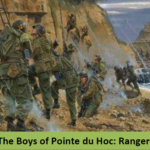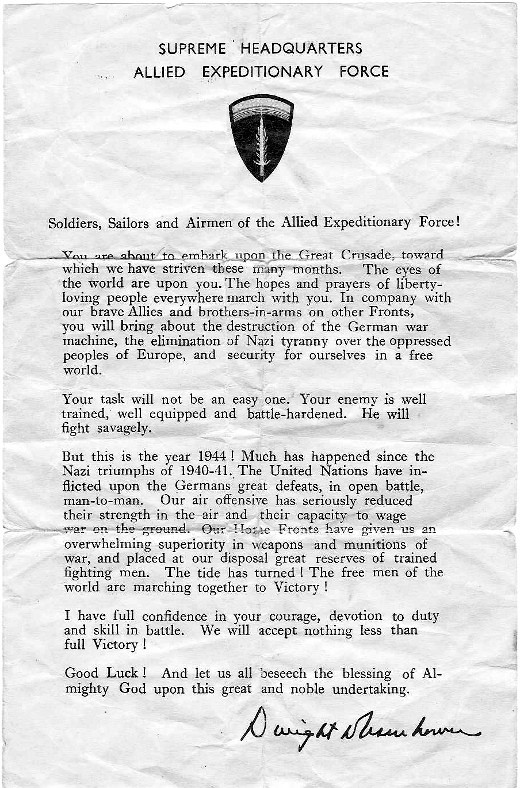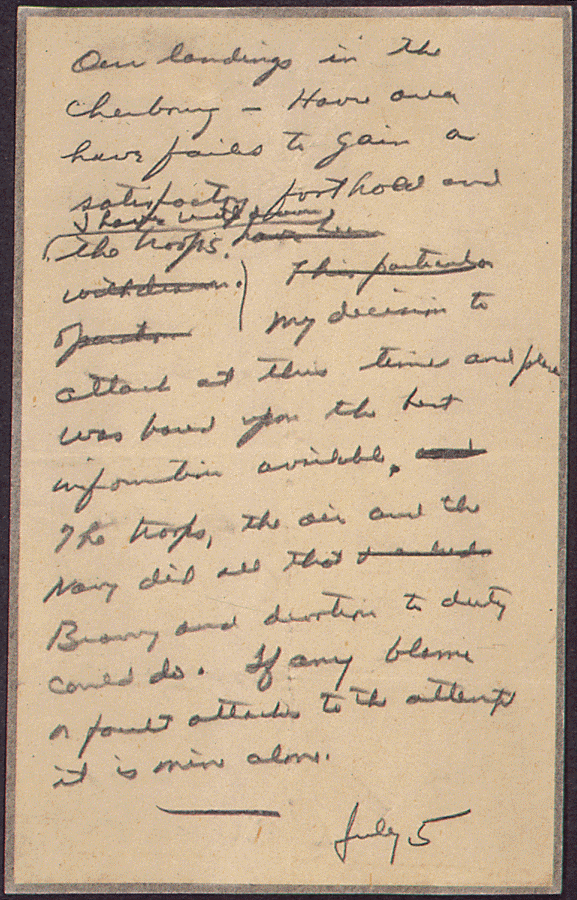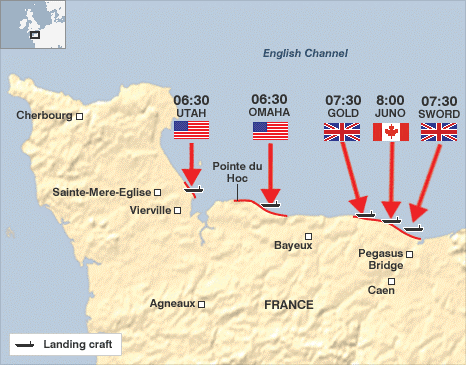“You are about to embark upon the Great Crusade, toward which we have striven these many months. The eyes of the world are upon you. The hopes and prayers of liberty-loving people everywhere march with you. In company with our brave Allies and brothers-in-arms on other Fronts, you will bring about the destruction of the German war machine, the elimination of Nazi tyranny over the oppressed peoples of Europe, and security for ourselves in a free world.” ~ First Paragraph of General Eisenhower’s letter to the Troops on D-Day, 1944
Thursday will be the 75th anniversary of D-Day, the day in 1944 that began the Allied invasion of Europe to end the Nazi regime that began its expansionist march in the late 1930s and by 1944 had extended it throughout Western and Eastern Europe and into the Soviet Union.
The allies advanced according to a highly secret plan called Operation Overlord. This plan involved the combined armies of the western allies in conjunction with the efforts of the Soviet Union to repel the Nazi invasion of Russia. These efforts against the Nazi regime proceded under the overall direction of the “Big Three:” especially U.S. President Franklin Roosevelt and Great Britain’s Prime Minister Winston Churchill — and as the war approached its end and afterward, the General Secretary of the Soviet Communist Party, Joseph Stalin.
The allied commander responsible for planning Operation Overlord and for executing that campaign was General Dwight D. Eisenhower. From today’s perspective in looking back and understanding how it all turned out, it is easy to forget what major obstacles and risks that those mostly young men overcame in that enormously important campaign, beginning on the beaches of Normandy.
Their ability to execute that plan, required an unprecedented enormous logistics capability that in turn resulted from efforts of American patriots at home who built in less than four years after Pearl Harbor the military capabilities that made that successful D-Day possible.
Their challenges in planning the Normandy invasion were manifold, beginning with the choice of an acceptable date. As preparations neared completion, I understand they wanted a full Moon to assure a high tide to bring our ships in close for our troops to disembark — and that led to June 5-6, 1944 as an optimum time — and I understand that the ships began boarding on June 4th, 75 years ago today.
But weather blocked June 5th. So, the morning of June 6th became the chosen day for the largest seaborne invasion ever attempted, involving some 150,000 soldiers landing on the Normandy beaches. Below is the letter from General Eisenhower to his troops that fateful morning. Click here for a video/recording of his historic message.
Despite his very positive message to his troops, General Eisenhower was quite conscious of the risks and that the invasion could go badly. This possibility led him also to prepare another letter in case of such a failure — happily never issued. A copy of his hand written draft of this letter is shown below.
Highly secret plans had been underway for months, a key part of a carefully constructed invasion game plan, including the combined operation of over 150,000 American, British and Canadian forces landing on five beaches code named Utah, Omaha, Gold Juno and Sword along a 50-mile stretch of French territory, as illustrated below. And the invasion was supported by allied naval and air forces in major preparatory and concurrent operations.
It was no small achievement that this complex operation completely surprised the German leadership. Key to the success of Operation Overlord was a major deception operation, led by the famed USA Lt. General George S. Patton.
Patton’s reputation in leading the Army’s previous accomplishments persuaded the German leaders that he was to lead the main focus of the anticipated invasion across the narrowest point between France and Britain. Click here for an interesting discussion of Patton’s “Ghost Army” and details of related deception activities preceding D-Day and a few references to Patton’s leadership of the Third Army after D-Day that led to victory and the end of World War II.
That deception plan succeeded extremely well. German Field Marshal Erwin Rommel, who no doubt was impressed by Patton’s reputation and had been charged by Hitler to protect France’s northern coast, did not return from leave until after the allied invasion was well underway. And other German Generals were so intimidated by “der Führer” that they did not awaken Hitler until the invasion was well underway.
But Rommel’s preparations with fortifications of bunkers, landmines, and underwater obstacles along the beaches posed significant challenges for the allied invasion, especially since mistakes were made in choosing where the troops were to disembarked in the face of blinding enemy fire that claimed 2000 American lives on Omaha Beach alone. More than 4000 allied lives were lost on D-Day, with thousands more wounded or missing.
Among the most memorable achievements was by “Rudder’s Rangers,” who scaled Pointe du Hoc’s 100 ft. almost vertical rock cliff (shown below) in the early morning hours to occupy that sniper/artillery post between Utah and Omaha. Click here for additional background on this extraordinary achievement and related activities on that fateful morning.
Today, a monument to the 2nd Ranger Battalion — the “boys of Pointe du Hoc,” as President Reagan called them on June 6, 1984, the 40th anniversary of D-Day — sits atop a cliff eight miles or so west of the Normandy American Cemetery and Memorial. The Pointe du Hoc Ranger Monument below was erected by the French to honor the men of the 2nd Rangers and their accomplishments on D-Day.
Click here for a video of Reagan’s memorable speech recalling the feats of all who fought that day, as we await President Trump’s address on Thursday.
No one who has visited the American cemetery near the Normandy Beaches of D-Day can forget the costs of being unprepared to deal with Hitler’s despotic regime. Those graves, and many others, illustrate the cost of ignoring the gathering storm that led to World War II. Dare we repeat that tragic error? And remember, Normandy is only a token of those costs of failing to be prepared.
Whenever I see pictures of cemeteries where American soldiers are buried, I remember former Secretary of State and Joint Chiefs Chairman Colin Powell’s 2003 comment that I quoted last week in my Memorial Day message:
“We have gone forth from our shores repeatedly over the last hundred years and we’ve done this as recently as the last year in Afghanistan and put wonderful young men and women at risk, many of whom have lost their lives, and we have asked for nothing except enough ground to bury them in, and otherwise we have returned home to seek our own, you know, to seek our own lives in peace, to live our own lives in peace.”
When I remember the cemeteries in France, where I understand about 150,000 Americans died in freeing France during World Wars I and II, I can’t help but recall what UN Ambassador Vernon Walters, who spoke seven languages and often served an interpreter for high level meetings, told me while I was negotiating with the Soviets in Geneva in the 1980s. He recalled that in 1966 a then arrogant French President Charles De Gaulle demanded that all American military leave France and that NATO headquarters be relocated (it turned out to Brussels), then Secretary of State Dean Rusk asked “What about the cemeteries?”
And De Gaulle just walked out without further comment. But France continued to partner with NATO, especially in our efforts to counter the Soviet threat — also an ally during World War II, but with its own nuclear Force de Frappe.
The French were very much a partner in President Reagan’s Strategic Defense Initiative (SDI) and, in particular, partnered with us during our negotiations with the Soviets in every discussion we had with our NATO allies, particularly at NATO Headquarters in Brussels.
We’ve had a steady friendship with a sometimes contrary ally ever since Lafayette showed up just in time at Yorktown to help end our Revolutionary War with another close ally today, Great Britain. I can attest that the French people near Normandy welcome Americans with open arms still today.
I already mentioned the efforts of the home front that made D-Day possible. At the beginning of World War II, we were totally unprepared. Our soldiers drilled with broomsticks and while their ranks swelled with volunteers, the young ladies, wives and mothers joined the factory work force as a “Rosie the Riveter,” to provide our troops with the weapons and delivery systems they needed to fight.
The above women above were at work in 1942 at Douglas Aircraft Company in Long Beach, California. These patriotic women, not only enabled that war effort, but set the stage for today’s continuing women’s movement. My wife’s aunts were among those who filled this critical mission after moving from Oklahoma to California. Such home front efforts enabled us, from a standing start in December 1941, to reach the stage of the beginning-of-the-end on D-Day in 1944 — just three-and-a-half years later.
Indeed, we all played a role with victory gardens in our cities, rationing of key materials to support the war effort and regularly engaging in Civil Defense exercises. America’s industrial base turned out weaponry at a record pace, which I doubt we can match today. I recall listening with my family to radio reports of our progress in the overseas war effort and rejoicing as things began to turn our way — and especially in the months following D-Day 75 years ago.
Today, we confront new challenging threats — now with adversaries that have far more dangerous lethal weapons than we confronted then. Moreover, we no longer have the inherent isolation of being an island nation — e.g., cyber threats have worldwide reach in the blink of the eye. Today’s weaponry includes orders-of-magnitude greater lethal potential, including by nuclear weapons that can be delivered within 20-minutes via intercontinental ballistic missiles (ICBMs). And while deception and clandestine forces continue to be included among modern strategies and tactics, modern technologies make that job much more difficult.
As noted in my recent messages, we are playing “catch-up” in some of these technological areas, particularly when it comes to hypersonic rocket threats and a growing space threat — while congress continues to dither in responding to President Trump’s valid call for a Space Force. We dare not continue to allow these threats to metastasize without a much improved response. To do otherwise is to invite threats much more problematic than those that led to World War II, and without the inherent capabilities that permitted us to rapidly recover.
It is long past time that we remove the inhibitions that for decades have hobbled our best engineers and scientists in developing effective defenses against these most threatening now proliferating threats to our very survival. In particular, we should again seek to meet President Ronald Reagan’s challenge that his Strategic Defense Initiative (SDI) find ways to protect America and our allies and friends from ballistic missile attack.
He was adamant that this search include space-based defenses — Soviet General Secretary Gorbachev’s demand that SDI studies be limited to the laboratory was why President Reagan walked out of the Reykjavik Summit. I was pleased to pursue his objectives, initially as his Chief Negotiator in the Defense and Space Talks with the Soviet Union and later as SDI Director under President George H.W. Bush.
We were well on our way to achieve President Reagan’s objective with the Brilliant Pebbles space-based interceptor concept — which the first four Directors of what is now known as the Missile Defense Agency believed was the most cost-effective defense produced by the SDI era: 1983-93.
But the Democrat controlled congress undercut those efforts during my watch as SDI Director, and then President Clinton’s Defense Secretary and former Chairman of the House Armed Services Committee Les Aspin, as he said “took the stars out of Star Wars” in early 1993. That state-of-affairs remained unchanged for a quarter century through both Democrat and Republican administrations. Time to “return to the future.”
Happily, there are some positive signs that maybe we at long last will be revisiting President Reagan’s perspective. The next sign as to whether these hope bear fruit in the near term will be evident as Congress returns from another of its recesses and deals with this issue in the coming weeks.
Stay tuned.
What can you do?
Join us in praying for our nation, and for a rebirth of the freedom sought, achieved and passed to us by those who came before us.
Help us to spread our message to the grass roots and to encourage all “powers that be” to provide for the common defense as they are sworn to do.
Begin by passing this message to your friends and suggest they visit our webpage www.highfrontier.org, for more information. Also, please encourage your sphere of influence to sign up for our weekly e-newsletter.
Encourage them to review our past email messages, posted on www.highfrontier.org, to learn about many details related to the existential manmade and natural EMP threats and how we can protect America against them. I hope you will help us with our urgently needed efforts, which I will be discussing in future messages.
Click here to make a tax deductible gift. If you prefer to mail a check, Please send it High Frontier, 20 F Street 7th Floor, Washington, DC 20001.
Please click here to read Past Weekly Updates!
Please help High Frontier continue this important and timely work!
Be sure to follow us on our Social Sites!
If you found this letter via our Social Sites, and you would like to subscribe, please click below!











